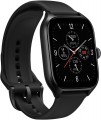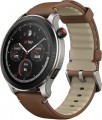Size
The size of the display installed in the gadget; for round screens, respectively, the diameter is indicated.
A larger screen, on the one hand, is more convenient to use, on the other hand, it significantly affects the dimensions of the entire device, which is especially critical for wearable gadgets. Therefore, manufacturers choose the display size in accordance with the purpose and functionality of each specific model — so that there is enough space on the screen and the device itself is not too bulky.
It is also worth mentioning that screens with a similar size may have different aspect ratios. For example, traditional smartwatches are usually equipped with square or round panels, while in fitness trackers, screens are often made elongated in height.
Screen resolution
Screen size in dots (pixels) horizontally and vertically. In general, this is one of the indicators that determine the image quality: the higher the resolution, the clearer and smoother the picture on the screen (with the same size), the less noticeable are the individual dots. On the other hand, an increase in the number of pixels affects the cost of displays, their power consumption and requirements for a hardware platform (more powerful hardware is required, which itself will cost more). In addition, the specifics of using smartwatches is such that there is simply no need to install high-resolution screens in them. Therefore, modern wrist accessories use displays with a relatively low resolution: for example, 320x320 with a size of about 1.6" is considered quite sufficient even for premium watches.
PPI
The density of dots on the screen of the gadget, namely, the number of pixels that are on each inch of the panel vertically or horizontally.
The higher the PPI, the higher the detail of the screen, the clearer and smoother the image is. On the other hand, this indicator affects the price accordingly. Therefore, the higher the density of points, the more advanced, usually, this gadget is in terms of general capabilities. However, when choosing a screen, manufacturers take into account the general purpose and functionality of the device; so that even a small number of PPIs usually does not interfere with comfortable use.
Bezel-less
Bezel-less are displays in which the case or bezel does not occupy the usable area of the front panel, or it is minimized. In terms of design, bezels have both pros and cons. One of the most important reasons for adding substantial bezels to your screen is physical protection.
The bezel-less display is very easy to scratch or damage when dropped. On the other hand, the frame takes up space on the screen, and this is one of the reasons why the frames in modern smartwatches are minimized, making the gadget more compact and stylish.
Battery capacity
The capacity of the battery that is installed in the gadget.
Theoretically, the higher the capacity, the longer the battery can work on a single charge. However, in fact, the battery life of the gadget also depends on its power consumption, and it is determined by the specs of the display and the hardware. Therefore, only models of the same type with very similar specs can be compared in terms of battery capacity; and for an accurate assessment of battery life, it is better to focus on the directly claimed operating time in one mode or another (see below).
It is also worth mentioning that high-capacity batteries inevitably turn out to be quite heavy and bulky. So the capacity of batteries installed in wearable gadgets is also greatly limited by size and weight.
Operating time (normal mode)
The time that the gadget can work on one battery charge (or the supplied battery) in normal use.
Normal mode, as a rule, means working with a relatively low load. At this time, the display can display some data, and basic functions can also work (counting steps, periodically checking heart rate, etc.), but in any case, power consumption is low. Therefore, the operating time in normal mode can be quite impressive, up to
several weeks, or even months. However, when choosing, it doesn’t hurt to also pay attention to the stated time in active mode (see below) — especially if a long operating time is critical, or you plan to use the gadget intensively. The actual autonomy of the device will most likely be somewhere in between these two values, depending on the actual load. If only the time in normal mode is indicated for the gadget, you should choose with a certain reserve.
Operating time (active mode)
The time that the gadget is able to work on one charge of the battery in the active mode of use.
For watch-phones (see “Type”), this usually means a talk mode, for other gadgets, an intensive work mode when numerous features and sensors are used and there is a constant exchange of data with a smartphone/tablet. However, the specific understanding of the "active mode" for different manufacturers may vary: some indicate the time at maximum performance (that is, in fact, guaranteed battery life), others — in some kind of "average mode". However, anyway, this is a fairly clear parameter that describes the battery life of a particular model quite well (and is much closer to real indicators than the time in normal mode mentioned above).
Note that for models with a GPS sensor (see "Navigation"), the specifications may additionally specify the time of active operation using such a sensor. See "Operating time (GPS)" for details.
Battery life (GPS)
The time that the gadget is able to work on one charge of the battery (or supplied battery) when using a GPS sensor.
This parameter is specified mainly for high-end tourist watches designed for experienced travelers, military, rescuers, divers, pilots, etc. Such devices use advanced GPS receivers, which themselves can consume quite a significant amount of energy; in addition, the operation of the receiver is inevitably accompanied by the use of other features — transferring navigation data to another device (usually via Bluetooth), working with its own built-in maps, etc. Therefore, the battery life while using GPS turns out to be rather modest — it can be significantly less time in active and even less in normal mode (for both, see above).
We also remind that the battery life mentioned in specs is approximate — in fact it may differ (in one direction or another, depending on the use scenario). Nevertheless, it is quite possible to evaluate the actual capabilities of the watch and compare them with each other: the difference in the claimed battery life usually proportionally corresponds to the difference in practical battery life.
Strap Options
—
Skin. Leather straps are typical for a business style, they look rich and respectable, however, they are quite expensive. On the practical side, this material is strong, reliable and resistant to moisture; at the same time, it is quite demanding to care for, and if the appropriate rules are not followed, cracks may appear on the strap.
—
Rubber/silicone. Quite a popular material used not only for fitness trackers, but also for traditional watches. Rubber straps do not look as rich as leather ones, but they are also quite decent, while they are strong enough, durable, resistant to moisture and pleasantly felt on the hand. Silicone is similar in properties, which in appearance is practically indistinguishable from rubber. But the silicone is softer, does not pinch the hand and is more pleasant to the touch.
—
Metal. Metal straps (bracelets) are mainly made of stainless steel, but there are other options. Anyway, bracelets are highly durable and can be both light and massive, depending on the composition of the metal. It is also worth mentioning the high thermal conductivity of this material. Such a bracelet pleasantly cools the hand in the warm season, but causes the opposite effect in the cold.
—
Milanese bracelet. Metal bracelets made of links of very fine weaving (about 1 mm in size, or even less). The m
...aterial of such a bracelet may be different; most often it is steel, but more expensive metals are also found. Anyway, such a bracelet has an original appearance, and also provides good air access, allowing the skin to breathe. Among the shortcomings of Milanese bracelet, it can be noted that the links can “bite” the hair on the arm, creating discomfort.
— Textile. Usually, strong dense fabric (like nylon-based CORDURA) is used for straps, resistant to moisture, ultraviolet and other adverse factors. For some users, this material is more pleasant than other options; however, for a number of technical reasons, fabric straps were not widely used.
Many models of wearable gadgets are available with several strap options to choose from.
